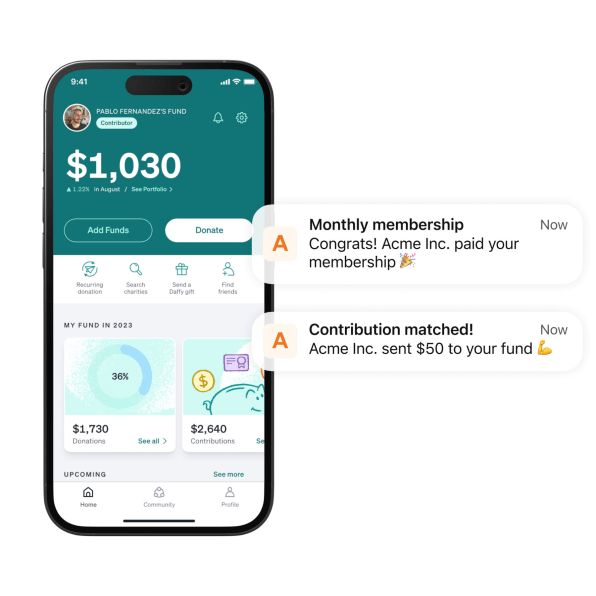Daffy for Work is a type of ‘charitable 401(k)’ that could unlock billions for U.S. charities
By Sam Becker
With rising costs stretching people’s budgets, most of us would be forgiven for being stingier with our money these days. But Americans remain generous, at least in terms of how much they donate to charity.
During 2022, individuals, foundations, and corporations gave nearly $500 billion to U.S. charities, according to data from the Indiana University Lilly Family School of Philanthropy. Individuals’ donations accounted for $319 billion of the total.
But there are potentially billions more that could end up in the hands of charities. Instead, that money often doesn’t get donated because of the friction that exists between an individual thinking about donating to a charity and then actually executing a transaction. Daffy.org, a platform that facilitates digital charitable giving, is rolling out a new way to reduce that friction, the platform told Fast Company exclusively. And it works pretty much like a 401(k).
The new service, called Daffy for Work, will allow workers to donate to just about any legal charity in the United States via deductions from their paychecks. Cofounder and CEO Adam Nash says the service marks a big step forward in the giving process.

“Daffy was born during the pandemic,” Nash says, noting that during that time, “fintech was innovating, but there was no innovation in the giving space. It’s a huge category. I think people underestimate how much Americans give.”
Roughly 60 million U.S. households donate to various charities in one form or another each year, Nash says. With that in mind, Daffy for Work was devised using a similar model to a 401(k), allowing individuals to set money aside in a donor-advised fund to donate to charities of their choice. This dynamic, Nash says, should hopefully lead to an increase in donations.
“If you set a goal and automate your savings, you’ll save more,” Nash explains. “It turns out, the same is true for giving.” As a result, he says, it’s possible that individuals could end up giving as much as 32% more to charity using Daffy for Work—and again, that money can go to any of the million-plus legal charities operating nationwide.
Getting employers on board
Daffy for Work is already attracting some big corporate names. The company says that Acorns, Lev, OpenAI, and Titan are all launching Daffy for Work. “Acorns is focused on looking after the financial best interests of our customers and team, through all of life’s stages. We’re excited to partner with Daffy to help our team give to the causes and organizations that are closest to their hearts,” said Noah Kerner, CEO of Acorns, in a statement supplied to Fast Company.
Nash says that around 65% of Fortune 500 companies already offer some sort of corporate giving program and that Daffy for Work will offer another option. And while the platform might function like a 401(k) for workers, the nuts and bolts are a bit different for employers looking to implement it.
For a fee starting at $3 per employee, companies sign up for Daffy for Work just as they might for another software-as-a-service tool, such as Dropbox or Zoom. Then, employers actually offer employees donor-advised funds, a form of tax-advantaged charitable giving account. Employees can choose the charities they wish to donate to and the amount they’d like to donate, and employers can decide on matching contributions or a per-year match.
It’s all designed to make giving to charity easier for workers, and for employers to offer another route to corporate giving—which may help attract and retain employees. In that sense, the service could be a win-win: Workers can reap potential tax benefits while conveniently giving to their chosen causes, while employers can use it to improve their corporate culture.
“Most people agree that giving to charity is a good thing,” Nash says. “We’re just shocked that there isn’t better software out there to help people do it.”
This post was updated with additional context about how the donor-advised funds and matching program work.
(13)



